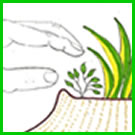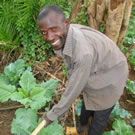Training for Individuals, Communities,
Nonprofits, & Local Governments
Become Adaptable and Resilient
Get road-tested, affordable, do-it-yourself solutions for a changing climate that YOU can launch NOW!
Start today with ‘8 Steps: Cut Your Carbon Footprint 50%.’
During the past few years while I’ve been working I haven’t had access a garden. Just a month ago I changed houses and have a little plot of ground now.
I began collecting seed packets a few months ago in anticipation of the move. Two weeks ago, I planted most of the seeds in inexpensive plastic seed flats. These will be transplanted from the flats into the the garden beds in a few weeks. I’ve planted flowers such as Marigold which have shown success in repelling insects. I’ve planted a whole range of salad material: different kinds of lettuces, arugula, spinach, tomatoes and onions. And I’ve planted a whole range of hot, spicy peppers.
Please look at the home gardening and composting resources at the bottom of this page.
 | Two weeks after planting the seeds I now have hundreds of healthy seedlings germinating. |
 | Behind the house, I’ve cleared two garden areas where I can begin to do direct seeding for things like peas and beans and potatoes and carrots—while I wait for my seedlings in the seed flats to mature. |
 | I love having a vegetable garden, but the reason that I’m developing one now, is that in looking at student projects from around the world, chronic malnutrition is one of the biggest challenges that the developing world faces—and I want to begin practicing what I preach. |
 | I was deeply affected recently by an article about famine conditions in a region of Guatemala called the Polochic. A journalist asked a group of mothers of severely malnourished children why they didn’t grow gardens to increase their available food. |
 | The answer was simple: they didn’t know how to start a vegetable garden and they didn’t want to embarrass themselves by failing. This had a big impact on me and was one of the main reasons that I began teaching home gardens for nutrition courses. |
On average 49.3% of children under five in Guatemala suffer from chronic malnutrition: the highest rate in all of Latin America and one of the highest in the world according to UNICEF. But in areas of the rural countryside the situation is more serious where more than 74% of children under five suffer from chronic malnutrition and 33% suffer from severe malnutrition. This can lead to delayed growth, learning disabilities—making it difficult for children to attend and concentrate in school—negatively impacting their ability to mature into productive adults.
Consequently, in teaching courses on food security, nutrition, and home gardens I want to make sure that I am a fellow participant in having a home garden. We have a six-month dry season—and a six-month rainy season. Right now it’s been raining steadily for two weeks and my newly prepared garden areas have been flooding. Several of my seed flats have fungus growing on the surface of the soil. When I’ve tried growing vegetables before many of my crops were destroyed by white fly.
But today before I plant any of my direct seeds, or my starts, I need to get some organic matter into my soil. In our home gardening course this is the first thing that we encourage people to do. Frequently, people are living in areas with depleted soil. The soil has been overused, it has suffered from wind and water erosion, or it has been abused by the overuse of fertilizer and monoculture plantings.
Our home gardening students also suffer from intermittent drought—punctuated by heavy rains and storms.
So the first thing we encourage them to do is to begin a restoration project for the soil. Degraded soil erodes more rapidly because of its fine, silt like quality. When it does rain, the rain doesn’t easily penetrate into the soil, and frequently just runs off the surface of the soil—taking soil particles with it. This impacts me the soil’s ability to retain soil moisture.
By adding organic material, you begin rebuilding a soil structure which has passageways for guiding and holding water, for supporting microorganisms, and for retaining soil nutrients.
In the first year of planting a garden, many families don’t have available compost. Adding any organic material will be a benefit. Leaves, chopped up twigs or cornstalks, cow manure, and kitchen waste added to the soil of the time of planting will begin to develop structure on day one—and will decompose over several months to become compost. Dry grass can be laid on top of planting beds as a mulch to reduce the impact of heavy rains during the rainy season, and to reduce evaporative losses during the dry season.
But as soon as you have your first planting completed, you should begin building a compost pile. This does not need to be a complex project. Laying a 6” layer of cornstalks or twigs or other dry vegetable matter in a layer on the ground will allow for air circulation. Following up with layers of green organic materials followed by manure followed by a thin layer of soil followed by kitchen waste will begin setting the scene for aerobic decomposition of these materials. Within a few months, you will have finished compost for your next garden bed. Please check out some of the links below for detailed information on how to do this.
Just like many of the community members that I work with, I don’t have a ready-made compost pile. In fact, over the past month, I’ve gone around to nurseries and friends to find out where I could buy some compost. They sort of cock their head and looked at me funny. Compost? I guess it just isn’t part of the local culture yet.
Fortunately, my co-worker Michelle Berkowitz, was at an agricultural meeting a couple of weeks ago, and met a woman named Marielos Merida who makes compost using earthworms. They mix cornstalks with manure, introduce earthworms, and several months later she has rich and wonderful compost. Marielos Merida is an agronomist with the Institute for Agricultural Science and Technology (ICTA) in Guatemala. Her specialty is organic agriculture.
Her organization sells this compost for five dollars per 100 pound bag. So I have placed my order—and Marielos will be delivering the compost on Wednesday—so that I can plant this weekend.
I already started building a compost pile a month ago when I moved in. Grass clippings, hedge clippings, and kitchen waste are all going into the new compost pile. I will use some of the worm compost to start a worm bin, and some of the worm compost to seed my new compost pile as well. Hopefully within 3 to 6 months I will have fresh compost for my next garden bed.
Please check into this blog in two weeks when I will have photographs of forming raised beds in planting the initial seeds.
Online Links:
South Africa: Live Eco: How to make your own compost heap
Downloadable Resources from the Center for Sustainable Development
How-To Card on Making Raised Vegetable Garden Beds and Planting Seeds
Lesson Plan for Leading a Community Workshop Making Raised Vegetable Garden Beds and Planting Seeds
Online Course on Food Security, Nutrition, and Home Gardens 1